
 |
|||||||
|
Sumner Strait |
CRUISING SOUTHEAST ALASKA ----North to Alaska! A cruise to the north conjures images of hardships and extreme conditions. Every cruiser knows a story of some tragedy in the north. ----Everywhere we have cruised, we have been cautioned by well-meaning folks, "It's dangerous out there -- you be careful." And they're right-- it is dangerous out there. However, we have found the most dangerous conditions are en route to our cruising grounds, on the highways, -- by far. ----It is always prudent, however, to find out about local conditions that might affect a cruiser's safety or comfort. |
HAZARDS

SEASON
-----There is only one season for comfortable cruising in Southeast - May, June, July, and the first half of August. Before and after that cruising window, winter gales become increasingly common and powerful. Then open waters are simply not safe, in our opinion, for a small boat. And, of course, every year is different.
WEATHER
---- We have talked about Southeast Alaska's climate in our tale, Close to the Edge. The day-to-day weather in Southeast (the daily effect of climate) is important to understand. Weather in Southeast is difficult to predict. There are fewer weather-recording stations here, due to the remoteness of the region and the fact that unoccupied ocean lies to the west - 'to weather.' Meteorologists can follow the general frontal patterns, but the effects of oceanic currents, islands, mountain heights, and vastness of terrain are obstacles that can't be overcome with today's technology.

A Weather Maker
-----However, some generalities may help a cruising boater. Winds are generally less in the very early morning and in last few hours before sundown. This can make life somewhat uncomfortable, since these are the times of day when most folks like to be sleeping or kicked back. Here in the higher latitudes there is very little night in June. Civil sunrise (when the horizon is clearly visible, as are the brightest stars) is about 0230. Sunrise is about 0345. Sunset is approximately 2145 and civil twilight around 2300. Nautical twilight, when the horizon is barely visible or fading from view, never occurs in mid-June. Therefore, we have left the hook at 0300 in the morning, when most land folks are just getting into their 'second snooze' and even the birds are silent.

Quiet Hour -- 0330 - 0430
-----We have memories of one evening, in Meyer's Chuck, untying lines at the government dock at 2030, after a day of heavy winds. Cruising neighbors from the other side of the dock shouted over, "Whatcha doing?"
-----"Heading out," was El's reply.
-----"Heading out? HEADING OUT?" was the response. "It's eight thirty in the evening - time for the evening video and a drink - and you're heading out?"
-----"Yep," El said emphatically, "Two hours left to cruise and the wind is slackening."
-----We left him, scratching his head, and lifting a glass to us as we cleared the harbor buoy. We had a delightful sundown cruise (and in June, sundown is a lengthy experience in these latitudes). The sea was calm, the wind flat, and the anchorage lovely when we dropped the hook at last light.
-----We met that cruiser later in Wrangell - they had left the Chuck mid-morning the next day. "Got the tar kicked out of us in the Clarence - in our 45-footer - should have left when you did."
-----The second factor about the weather is that it will rain today - tomorrow - and the next day! The NOAA weather prediction up here is like a stuck needle on a record - "showers likely" "showers likely" "showers likely." The monotony of the forecast is occasionally broken by, "Rain." In our six-week cruise we had several days with no rain at all, a few with sunshine that lasted a few hours, and many with "sunny breaks," although never once -- NOT ONCE - did NOAA mention the nasty word, sun!
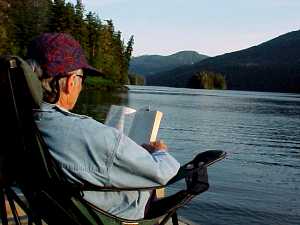
A Sunny Break
-----Most forecasts sound like the odds makers in Vegas - "60% chance of rain in the morning - 40% chance of evening showers." To us, who see cups half-full in life, that translates to "40% chance of no rain - 60% chance of no rain." However, we have discovered that that's not how folks here see it.
-----A Juneau resident summed it up succinctly, "There aren't any clothes lines in Juneau."
-----Yeh, it rains a lot in Ketchikan. Is it the rainiest city of greater than 5,000 people in the US? Well, I suppose it might be - never thought of it that way. Yeh, we get about 160 inches per year - must be about five times what Seattle gets. But, it's not bad. We're used to it. Only time it gets rough for me is after about two weeks of continuous hard rain in the winter - when we only have a ration of a few hours of brightness at midday - yeh, then it can get a little rough. - a Ketchikan resident
El Sees Her Shadow
-----We were invited by south-bounding cruising friends to look at the pictures they had been taking this summer on their Alaskan cruise. Every picture was blue sky, with big puffy white clouds. "Looks like a summer sky in Arizona," El said. "How did you get so lucky when it's been raining and gray where we have been?"
-----"Oh, it was raining and gray with us as well. But my computer photo enhancement program has a neat trick. You can 'dub in' any background sky you wish. You're right - those skies in our pictures are Arizona skies - I photographed them last winter and now I just 'paint' them in for our Alaska pictures."
-----By the way, our pictures, on this website have nothing 'dubbed'! What you see is what we saw - take it or leave it.
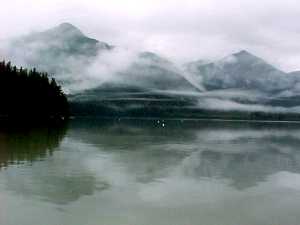
Gray is Beautiful, Too
-----At first, coming to Southeast from a month on Lake Powell in Arizona, it seemed dreary with the gray and wet. However, soon we got used to walking around without rain gear like the locals. The damp bed sheets and clothes felt normal. We really appreciated the enclosed cabin and our "add-on" canvas cover over the cockpit. Expect rain and we guarantee you won't be disappointed.

Sign in Sitka Book Store
-----It is also cold or cool much of the time. Once, just once, our thermometer found the 70-degree line. In June, we had evenings in the upper thirties. Bring your warmies and lots of juice for the Wallas stove. By the way, the locals are no guide - they wear t-shirts every day after they turn the calendar page to June -"It's summer, you know."
-----Winds are generally light in the summer. That, of course, is relative to the rest of the year. They are usually forecast in the 15 mph range. Naturally, they vary locally and are often considerably higher when there is a frontal system. Winds here are heavily controlled by topography. And the topography is controlled by geology. The primary geologic trend in Southeast Alaska is northwest/southeast and so are the major channels and sounds. The secondary trend, northeast/southwest, controls many of the arms extending off the major sounds.
-----We soon learned that a wind prediction of north only means that the wind will travel directly down the northwest or northeast channel and strike us directly on the bow. Similarly, any wind from the south will be square on the stern. Now it's up for grabs when you are in a northwest-trending channel and the wind prediction is from the northeast - and so on. The only thing for sure, is the wind will funnel either up or down your channel directly and there will be little protection from a lee shore.
-----You fellers from outside talk about winds that are northerly, southerly, easterly, or westerly. Must be nice to have such a choice. Here, in Southeast, we only have two winds - noserly or, once in a great while, a rearly. - a Southeast sailor
-----Fog is another factor here. We had little trouble this summer, but that varies from year to year. The cold ocean and warmer land (or sometimes, the warm ocean and cold wind sliding down from a glacier or a snow-capped mountain) often collide to make dense fog. Fog here is not always windless - sometimes it blows a gale through the fog. Radar is handy.
 --
--
Radar Weather
LOGGING SLASH
-----Aside from the weather, the major cruising hazard is a log. Everywhere there are logs. We have cruised miles offshore, and still there are logs.

-----You must keep your eyes riveted to the water, constantly aware of the risk. This can result in real eyestrain, especially if you are cruising into bright water and reflections. A chop is another difficult time. Every dark wave ahead looks like a log -and every log looks like a dark wave.
-----Gulls are most helpful. They enjoy sitting on a log and cruising along with the current, and, thankfully, they are white. We think of these sentinels as our flying buoys, and never before have we thought so kindly of a gull.
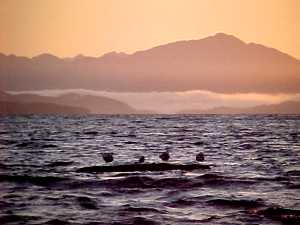 --
--
Thanks, Gulls--------------- Marking a Very Long Log
-----We met a cruiser on a float in Ketchikan. He was in a 27-foot powerboat. He had a miserable time in Southeast, and couldn't wait to get back to California. Not only was he tired of the almost constant rain, but he had lost four props to logs. Each time he had to be towed to a distant harbor.
KELP
-----Seaweed is a problem when it is caught in the rush of the tidal change. Right along the tide line, where weed is swept from bays and concentrated at the meeting of the tides, it is often so thick it can be a problem for your propellers. We just cut back and drift through those tidal boundaries. Besides, logs and other larger debris often lurk along those borders and present a far greater hazard than kelp to props and hulls.
 --
--
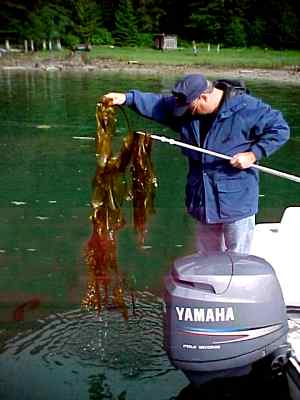
A Tide Line ---------------Chris Cleans Kelp from Rana Verde
ICE
-----It was a dark night in Frederick Sound. Three of us were running together for home - holds full of fish. Our thoughts were on family, dinner, and the warmth of a fire. We had been out fishing day and night for what seemed eternity. Now, dog-tired, we half-dozed at the helm, eyes straining into the blackness outside the darkened pilothouse. We drank hot mugs of coffee to stave off exhaustion. The radar dimly lit the cabin interior - shoreline showed as a ragged dark edge to the screen, and the two 'bips' of our companions showed off to the starboard. Suddenly the radio screamed with a frantic voice - "Geeze - we hit something - hard! The bow's stove in … Taking on water fast … Get over here … quick. She's going down …" Instantly awake, we spun the wheel hard over. We got there in time to get them off. There was nothing we could do for the boat. The hold was full in a few minutes and she went down fast.
-----It was ice - calved off the glacier and drifting down the Sound in the blackness. There was nothing showing on the radar - I know - I had just checked it. But, then, we all knew that ice often doesn't reflect. We used to joke about floating rocks in the Sound. Any of us could have hit that berg that night - it's the luck of the draw. The story doesn't end there, though - that skipper just had terrible luck. Not long after, in a horrific winter gale up by Five-finger Rock, he, two of his children, and his new boat disappeared. No one was there to help - only one body was recovered. - a friend
--

Bergs
-----Ice is only a problem near the bays that have a calving glacier - Frederick Sound with LeConte Glacier, Stephens Passage with the twin Sawyer Glaciers, and Icy Strait with all of Glacier Bay above. Near the glaciers, the bergs that are clear as glass and rounded are the most difficult to spot visually or with radar. In a collision, they are also the most dense and hazardous.
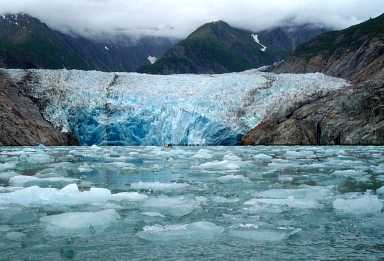
The Small Dark Spot in the Middle Near the Glacier is Halcyon
TIDES AND CURRENTS
-----Virtually every marina, at least in the early part of the season, has a "Dot's Fishing Guide Tide Table," complete with correction tables, for the area. Many charting software programs also have tides marked. It is essential to know the tide, since the range is often in excess of 20 feet. These tides are "mixed semi-diurnal," which means that there are two highs and two lows every day, and that one of the highs is higher than the other and the same with the low. If you like to anchor in about 10 feet of water, with a 5 to 1 scope, watch the tide! If your sounder shows ten feet and you play out 50 feet of rode, and you are at high tide, you will soon be perched on the mud or rocks. Conversely, if you are there at low tide, you will be sitting in 30 feet of water at the high and won't even have a 2 to 1 scope - a wind is liable to trip your anchor in the night.
-----Many of the arms and bays of Southeast are miles from the open ocean. Every 6 hours, a flood of water has to pour in torrents through narrow channels to bring in or out the tide. Currents in excess of 5 knots are common. In a few places, rapids or saltwater falls occur. Even with our planing hull, the current set affects our fuel capacity. A Scotsman reads the tables and goes with the flow.
-----The swirls and rapids at flood tide can be awesome and even dangerous for boats many feet larger and with engines far more powerful than ours. It pays to travel through the 'tight spots' at slack water.
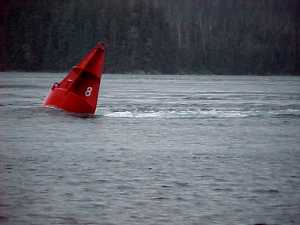
KUSHTAKAS
-----Every Culture has its "little people." Germany has its Trolls, who commonly live under bridges and extract food or other tolls from passersby. We had one in southern Nevada for years, who lived in a culvert under the Nipton grade. People routinely left him food, magazines, and water beside the road. All was fine for years, until a huge rainstorm and a flash flood. He has not been seen since that event.
-----In Sweden, the Tomte live under your house. They are very helpful little gnomes who will sometimes do the dishes, chase away skunks, and keep the fire glowing all night. Of course, if there is discord between residents of "his" house, the Tomte is very unhappy. He then becomes mischievous and sometimes downright mean. You want to be on their good side.
-----In Hawaii, the Menehuni serve the same role. They can be helpful or roguish, depending on their neighbors or, perhaps, the phase of the moon. We have a wonderful Menehuni who happily lives on Halcyon, and a welcome passenger he is. We never see him, he is perfectly quiet, and never a bother, but he does one very useful chore - and only for the payment of an occasional chocolate nugget left on the table overnight. He dumps, cleans, and maintains our porta potty in beautiful operating condition.
-----In Alaska, there are Kushtakas. We mentioned, to an old-timer harbormaster, our intention of cruising to Thomas Basin. The spider-armed inlet lies just northerly and around the corner from Petersburg. He notably blanched. A dark and serious look came over his face, and he virtually whispered to us, "I wouldn't do that if I were you. Do you know of the Kushtakas?" We did not. He asked if we had read the old tale entitled, "The Strangest Story Ever Told."
-----We said, "No."
-----He walked slowly away, with frightened glances over his shoulder. He was mumbling, as if to himself, "I will never return to Thomas Basin" and disappeared into his office. We could hear the loud "click" as he locked his door.
-----The next morning we went to the library and asked about the story. The librarian shook her head as she asked, "Are you on a boat?"
-----"Yes," El said in her cheery voice.
-----"Are you going to Thomas Basin?" she asked with a wince as she said the name.
-----"We intended to," El answered. "Is there something we should know about the place?"
-----"Yes," she blurted out abruptly and disappeared.
-----I headed over to the computers and the Internet connection and El found the book section on Alaska. She was only there a few minutes when the librarian returned. "Here," she said in a whisper to El, handing her a small, well-thumbed book. "Bring it back, and give it only to me when you are finished" - and, with a furtive look over her shoulder, she disappeared into an inner office.
-----El read the book, the one the harbormaster had mentioned, "The Strangest Story Ever Told."
-----"This might be more important to read than the Cruising Guide," she said with a smile, as she handed me the book to read. "It is an amazing tale of vicious, dark, hairy, little creatures. A story of men gone mad and others who disappeared forever. The list of horrors that have occurred to visitors of Thomas Basin range far back in native legends into the mists of time."
-----When it was time to leave the library, El found the librarian in her inner sanctum. She palmed the book into her desk as though it was "banned in Boston."
-----"Don't go there," is all she said to El.
-----We were at the Post Office picking up our mail later in the day. While waiting in line, we visited with a local fisherman. He asked about our cruising direction. "Oh, probably off to LeConte Glacier and then over to Thomas Basin for a few days."
-----A dark frown clouded his face. "You'll enjoy LeConte. Treat the ice with respect. But, if I were you, I wouldn't go to Thomas Basin." Before we could ask more, the clerk called us to the counter.
-----"Did I hear you say you plan to cruise into Thomas Basin?" she asked frowning.
-----"Well, we're thinking about it," El answered with some hesitation. "What do you know about it?"
-----She left the counter but shortly returned with our mail packet. "My husband and I know the stories about the Kushtakas - do you know about them?" she asked with knit brows.
-----When El said she had read the tale, the clerk continued -"Well, so had I - and heard many a story from Natives and fishermen. 'I don't believe that nonsense,' I told myself. 'This is the Twenty-first century, an age of scientific reason, and there's no room for such superstitious nonsense.'"
-----"Well, my husband is an avid recreational fisherman, and he asked if I cared to go fishing with him for a long holiday weekend coming up. 'Sure,' I said, 'Where to?' I love to stay on the boat - grew up with a fisherman father who took me out with him whenever I could go."
-----"'Thomas Basin', my husband said, with a sorta twisted smile on his face. 'Nobody goes there with those old stories, so the fishing must be great.'"
-----"Well, I must say, it slowed down my enthusiasm, but those were just old irrational tales, I said to myself, so agreed to go."
-----"That was a terrible mistake. Let me just say one thing about that weekend - We stayed but one night. Alaskans travel with firearms in case we go walking in the woods - protection from bears, you know. Well, that night we stayed awake all night - at anchor. We each had our sawed-off twelve-gauge doubles in our laps - for the first and only time in either of our lifetimes - on a boat - they were loaded."
-----El quickly asked, "What happened?"
-----"No time to talk - other folks in line - but -," she quickly whispered the words, "the glass in a window shattered … we both saw dark hair-covered 'things' on the bow rail …NEXT! …"
-----She beckoned over the next person in line - the fisherman we had been talking with in line. He sidled by us, staring deeply into our faces, fear etching the lines in his weather-beaten face. "Don't go there," he said in a voice husky with emotion.
-----We were sorting our mail at a table in the Post Office Box room, when the clerk from the counter next to the one with the Thomas Basin tales walked over to us. "Couldn't help but hear the stories she was telling you. Let me tell you our story - my husband is a logger and we lived at a camp in Thomas Basin for years - even had our children with us - never a problem - nothing. Those are just tales told by the superstitious. Don't believe them."
-----We headed out the next day, with Chris on Rana Verde, for LeConte Glacier. When we returned to Petersburg to refuel, we asked Chris if he wanted to keep us company over to Thomas Basin for a night or two. "Sure," he said innocently, unaware of Kushtakas. To be fair, we briefly mentioned them to him, and, naturally, he scoffed off the stories.
-----So, we went to Thomas Basin. As we entered the intended anchorage, it began to rain - hard and cold. We dropped our hook using the windlass, and it held at the first try. Chris, anchoring alone, had to go to the bow to set and cleat his anchor. It failed to hook time and time again. Finally, after he was soaked to the bone and cold to the core, it held. Exasperated he radioed to us - "It must be an underwater Kushtaka. This is Ruth Cove, so her name must be Ruth - and she kicks the anchor off the bottom every time!"

Chris, the next morning, with his now-famous "Thomas Basin Double-set"
-----Sitting to read that evening, a cold wet drop of water landed "splat" on that bald spot on the top of my head that I have been nurturing along for years. We had sprung a roof leak - the first time in two and a half years aboard. Soon, it was a virtual stream, coming through the bolt that held on the cabin rail. Couldn't fix it in the rain, so there I sat - drip - drip - as Ruth gave me the Chinese water drop treatment.

Bill, reading in Thomas Basin (See the Hairy Thing on the Bow Rail?)
-----The next day, we left Thomas Basin.
 ----
----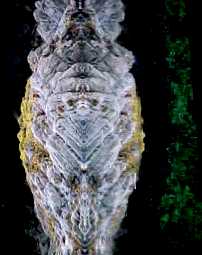 -----
-----
Kushtakas? (Or Reflections? [turn sideways])
INSECTS
-----We had only a few evening experiences with no-see-ums and none with mosquitoes. There were some mighty mean, but slow, Green-eyed Horse Flies around a few docks. We came equipped with all our bug-armor (head to toe netting we have used on Arctic canoe trips), but only used the head net portion one night for no-see-ums.
-----We did, however, have a pet arthropod. Charley joined us in Washington before our cruise north. He lived under the overhang outside our starboard window -- the one over the stove, where he could be warmed on cold evenings and mornings. He spun a web every night and we visited every morning as I made early morning coffee. When we returned to the San Juan Islands, a much fatter and happier Charley jumped ship to join his family at Friday harbor. Oh, the tales he could tell ...

Charley's Web
CRUISE SHIPS AND BLUE CANOES
-----There are other ways to cruise the Inside other than on a 22-foot boat. We were tied off at the Ketchikan Yacht Club docks when two ladies dressed in 'finery' strolled slowly by the dock. They were peering at and into boats, making nasal snuffs as though they were checking out panhandlers on a street corner. They spotted El in the cockpit reading. "Are you an Alaskan?" one asked, rather hoping to observe the rare species.
-----"No," El answered with a smile. "We're here cruising the Inside."
-----"Oh," came the disappointed response. "We were so hoping to meet a native. We're cruising the Inside, also." They turned and returned to their mob on the street above - all 2,000 of them, from their Princess Cruise.
-----There are two hazards we found from the cruise ships - first, their passengers overwhelm the small towns they visited. Ketchikan is a fair-sized town. However, when four cruise ships arrive, the town's population doubles. Wrangell, with 1,800 residents, chokes.

Ketchikan - Three Big Ones and Two More Anchored Outt
-----The second hazard is more serious. A cruise ship is a very large vessel and they move amazingly fast. In the narrow channels and foggy sounds they can be a real threat to a small boat - even a fast one like ours.
-----Chris was several hours ahead of us crossing Sumner Strait. It was a drizzly, foggy, gray morning. As we left Rocky Pass heading into Sumner, he radioed to us. "A little lumpy out here, but not bad. Good cover from Sumner and Strait Islands. But..." he added in afterthought, "…watch out for the cruise ship eastbound. It's white and hard to see in the fog."
-----We peered through the misty windscreen into the misty whiteness - nothing. The radar was set at a one mile range - nothing. We turned the setting to three miles, and there it was - reflecting with far greater brilliance than the islands. A quick calculation showed intersecting courses. We turned eastward to give her ample room to go by on our starboard. Finally, even knowing exactly where to look from our radar screen, we spotted her, closing fast, with silent menace.

See the Silent Menace?
-----We shortened the radar range back to a mile to keep a close eye on her movements, knowing that if we showed at all on their radar we were probably lost in the sea clutter of the swells. We have traveled in the pilot house of large ships and know that the wheelman often determines his course by the GPS and then puts the helm on autopilot while he and others drink coffee, chat, and once in a while, look out ahead or at the radar.
-----After she safely passed, and before turning our course back to the south'ard, we ranged out farther with the radar - just in case. Yes, you guessed it - another huge blip on the screen, exactly trailing the course of the first cruise ship but four miles behind. We turned into the wake of the first ship and scooted southerly, between the cruise ships, keeping a beady eye on the radar.
-----No roads connect Southeast towns to the outside, except Skagway and Haines in the north. None of the towns we visited had highway access. Even the state capital, Juneau, does not link by road to anything but its 'suburbs.' Consequently, Alaska has used highway road funds to 'build' a Marine Highway. A fleet of fine vessels, the Alaska ferries, bonds southeast communities with a fine marine highway.

Rana Verde Meets the Blue Canoe bound for Sitka. "Ahh, one whistle pass? ... Sir?"
-----We met the "Blue Canoe," as Alaskans affectionately call their ferries, in the Wrangell Narrows - not the best place to meet an Old Town Canoe, let alone a large high-speed ship. They have a schedule to keep and they're on their highway. Fortunately, we were at a wide spot in the road and could slip into the channel behind Battery Islets to let the Kennicott have her way.

The "Blue Canoe" Kennicott in Wrangell Narrows
TOWS
-----The eighteen-wheelers of the waterways are the tows. We have had plenty of experience with them cruising the coasts and rivers of America and have developed respect - for their skippers and their skill - and for the potential menace to small boats. In Southeast, the tows pull barges with a ve----------ry long cable. At night or in a fog, out in the Sounds, they look like two boats and show as such on the radar. We follow a never-to-be-broken rule: don't pass anywhere near the stern of a towboat. We have heard horror stories from captains about boats cutting between the tow and their pulled barge, unaware of the long steel cable linking them. They are too grim to repeat here, but suffice it to say, they underline our rule.

FISH NETS
-----Whenever you spot a fishing boat that is under full way, start looking for either the orange balls or a string of white floats. We have the same rule with fishing boats as we do for tows: Never pass astern. We have added the corollary for fishing boats: If they are not full underway, we immediately slow down, scan the water for anything floating anywhere near the vessel, and chug along very slowly, always watching for buoys or floats.

-----We were cruising along at about 20 knots in a calm sea. There were fishing boats around, but they seemed to just be circling and puttering. Suddenly our boat stopped with a lurch and the engine died. I thought we had gone aground, but we were miles from shore. Then I saw them - small red fishing floats stretched off in a line both directions from us. I lifted the outdrive, and sure enough - net! We had run smack into and through a fishing net! I was able to untangle or cut off most of the net caught in our propeller, and fortunately the engine started and we could get underway. I say, fortunately, because one of those fishing boats was barreling full speed at us. Now, I was in the Navy for years, and that fisherman, over the VHF, was screaming epithets about my ancestry I never heard before.
-----We scooted out of shotgun range as fast as we could, but our engine didn't seem to have full power. That night, in the marina, I unwound another long tangle of net still wrapped on the drive. Now, I ask you, how was I supposed to have seen those little red floats? - from the owner of a 28-foot California registered boat.
HAZARDS, ETC.
Ladies of the Night------
OVERNIGHTING
ANCHORAGES
-----There is usually a delightful and sheltered anchorage within five miles of wherever you are in Southeast. The only exceptions are the crossings of the wider sounds or straits. The numerous small coves and bays are one of the most delightful aspects of a cruise along this coast. Seldom do you share an anchorage with other humans, but frequently with seals, bears, and loons. The Douglass Cruising Guide has most of them described and charted, and we strongly recommend the book for cruisers of these waters.
-----It is more difficult to anchor in Southeast than most other cruising areas. Glaciers scoured deep steep-sided valleys, and most shorelines drop off hundreds of feet within a few feet of shore. However, our 300 feet of rode with 20 feet of chain found bottom. Our Bruce anchor held, usually on the first set, in all our overnight stops. The pleasure of swinging light and free on a hook in a beautiful cove is one of the greatest pleasures of cruising.
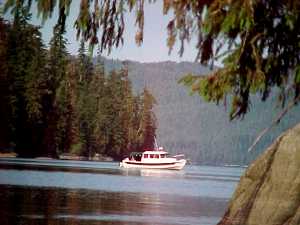
FLOATS AND BUOYS
-----Alaska maintains a number of floats or docks throughout Southeast. They are a great place to tie and walk ashore to stretch legs. They can be social centers on the waterways and we met many fine folks tied off to a State dock.
 --
--
-----The National Forest Service has small cabins located in many scenic spots throughout the area. These can be rented for a reasonable price, with prior reservations, and offer a delightful getaway for local people or tourists alike. Most are only boater accessible, with their own float or buoy for the occupant's boat. Those renters 'own' the tie for their night's rent, but we found other folks often tie-off if the adjacent cabin is unoccupied.
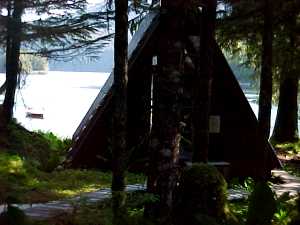 -
-

MARINAS
-----Every town has at least one marina, usually owned and operated by the municipality. They are crowded with local boats, many of them commercial, but all offer shore facilities that sometimes include a shower. One of the distinct pleasures of cruising, for us, is the chance to visit towns en route. Each has its own personality and characters, and many of them hang out near the waterfront. The overnight tie-up in Southeast is reasonable, sometimes includes an electrical hookup, but it is occasionally difficult to find space. We have often heard the words on the VHF from a harbormaster, "Oh, we can always find room for your little boat," with mixed emotions. We know we will have a tie, but goodness knows where.
-----Most liveaboards in Alaska marinas have pets. This can make for some noisy neighbors (one of ours had a loquacious parrot!). We learned to walk the docks as though they were minefields, because of the 'calling cards' left by dogs. The nearest grassy patch at the top of the ramp from the docks is very green.

DETAILS
FUEL
-----Every town of any size has fuel. We always asked 'ahead' from fuel stations, marinas, and other cruisers about fuel availability at the smaller outports. We carried three 5-gal containers as spares and used them several times to extend our range and avoid backtracking for fuel, and found, with judicious planning, that our resultant 55-gal capacity was fine.
 -----
-----
The Fueler and the Spare Fuel Tanks (with stove fuel stored ahead of the tanks)
PHONES
-----All the towns (and some smaller communities) have cellular coverage, but of course, there is no service when out on remote water. Public phones are available at marinas and sometimes in remote spots.

Myers Chuck
NEED A DENTIST?

El in her on-board Dental Chair (Dental Boat Jenny B)
(07/03)